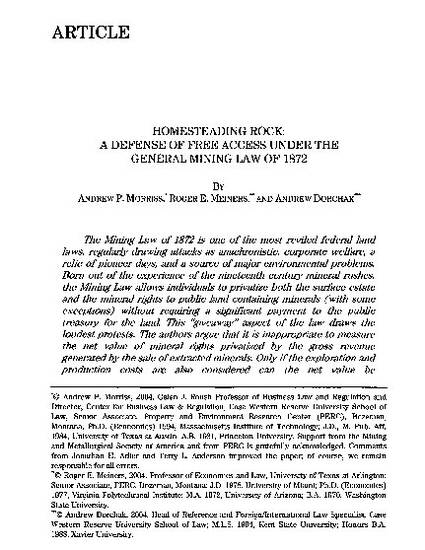
The Mining Law of 1872 is one of the most reviled federal land laws, regularly drawing attacks as anachronistic, corporate welfare, a relic of pioneer days, and a source of major environmental problems. Born out of the experience of the nineteenth century mineral rushes, the Mining Law allows individuals to privatize both the surface estate and the mineral rights to public land containing minerals (with some exceptions) without requiring a significant payment to the public treasury for the land This "giveaway" aspect of the law draws the loudest protests. The authors argue that it is inappropriate to measure the net value of mineral rights privatized by the gross revenue generated by the sale of extracted minerals. Only if the exploration and production costs are also considered can the net value be determined. Once these costs are considered, the net value of mineral rights privatized under the Mining Law is relatively small. In this Article, the authors argue that the attacks on the Mining Law misunderstand the statute's institutional incentives. The mining industry is a heavily capital-intensive industry whose activities involve significant risks and long lead-times. As a result, mining firms are extremely vulnerable to expropriation, as their experience in much of the rest of the world amply demonstrates. The Mining Law creates an institutional structure that reduces the expropriation problem and forces owners of mineral lands to address the opportunity costs of their land-use choices by effectively "selling" the land in exchange for the production of information about the mineral resources under it rather than for money. By providing mineral rights owners with the option to receive the surface estate as well as the mineral rights for a nominal fee, the Mining Law helps deter opportunistic behavior by the government. Since expropriating a mineral rights owner who also holds the surface estate would reduce the value of all land titles, the Mining Law raises the cost of expropriation. Full title also solves incentive problems that exist where rights holders have more limited titles. Ownership of both surface and mineral estates gives the property owner the incentive to maximize the joint value of the two estates. If the mineral rights owner does not hold the surface rights as well, activities which are destructive of the surface estate are more likely to occur. Providing a straightforward, administrative system for privatizing mineral rights that does not allow the agency charged with privatization discretionary authority minimizes the opportunities for corruption as well. Given the prevalence of corruption in the mining industry elsewhere in the world, this is an important advantage of the Mining Law's non discretionary approach. There are competing demands for lands containing mineral resources. A potential mine site may also be an ideal habitat for wildlife or a picture-perfect ski run. The Mining Law's privatization of both surface and mineral estates solves the conflicting use problem by giving the owner of the mineral estate the surface rights as well. If mining will reduce the surface estate's value, the mineral rights owner will then suffer the loss. Seen in this light, the nonmining uses of land privatized under the law (a frequent complaint of critics) actually demonstrates the success of the law at resolving these conflicts. Moreover, because the Mining Law does not require mining on land privatized under it, interest groups favoring preservation can use it to preserve the land. Finally, the Article addresses the claim that mining produces harm to neighboring lands. The authors show that only environmental spillovers unique to mining justify mining-specific restrictions on property use. The Article also tests the incentive theory developed against the history of modifications of the Mining Law (resource and land withdrawals), the quite different practice of the states with respect to their public lands, and by comparing the Mining Law to the other major nineteenth century land disposal laws, the Homestead Laws. Homesteading has been criticized for overly rapid privatization of land and for causing rent-dissipating races for property rights. The authors argue that the Mining Law avoids the problems of the Homestead Laws because the "race" it induces is a race for useful knowledge, not a race won by enduring hardship. The Mining Law also does not require that the land privatized be brought into production as the Homestead Laws did. The resource withdrawals (fuel and "common" minerals) can be explained by a combination of technical characteristics (e.g., the pool nature of oil and gas reserves) and interest group politics (military interest in controlling domestic oil supplies). Federal land withdrawals from Mining Law coverage also do not undercut the incentive analysis of the Mining Law, as these withdrawals are of land dedicated to particular uses by the federal government and acquired lands where allowing privatization raises serious agency problems. States' failure to adopt a similar method for privatizing their mineral lands is also explained through a comparative analysis of state and federal agency costs.
Available at: http://works.bepress.com/andrew_p_morriss/136/
